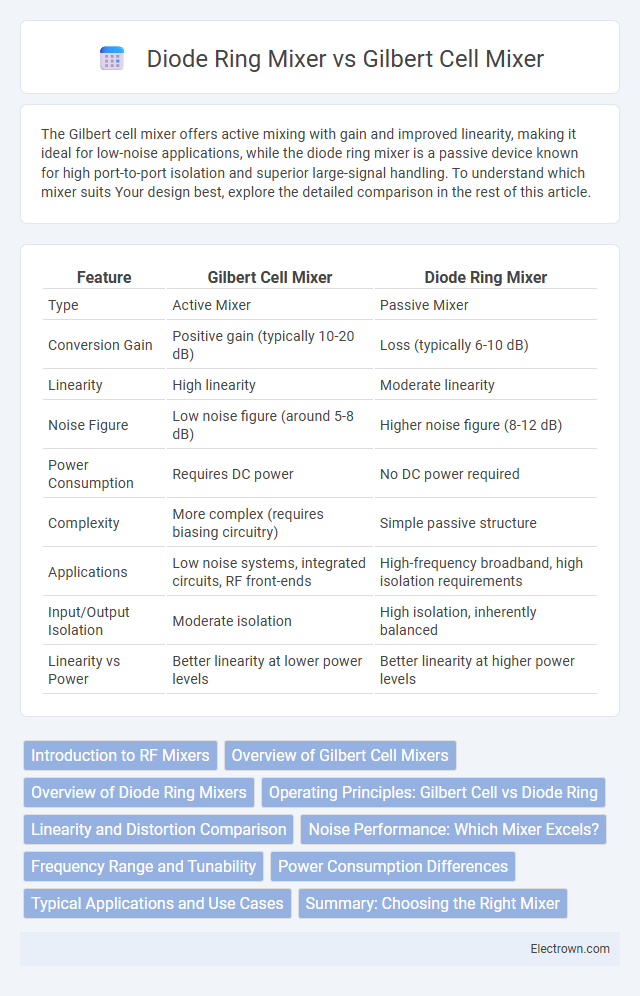The Gilbert cell mixer offers active mixing with gain and improved linearity, making it ideal for low-noise applications, while the diode ring mixer is a passive device known for high port-to-port isolation and superior large-signal handling. To understand which mixer suits Your design best, explore the detailed comparison in the rest of this article.
Table of Comparison
| Feature | Gilbert Cell Mixer | Diode Ring Mixer |
|---|---|---|
| Type | Active Mixer | Passive Mixer |
| Conversion Gain | Positive gain (typically 10-20 dB) | Loss (typically 6-10 dB) |
| Linearity | High linearity | Moderate linearity |
| Noise Figure | Low noise figure (around 5-8 dB) | Higher noise figure (8-12 dB) |
| Power Consumption | Requires DC power | No DC power required |
| Complexity | More complex (requires biasing circuitry) | Simple passive structure |
| Applications | Low noise systems, integrated circuits, RF front-ends | High-frequency broadband, high isolation requirements |
| Input/Output Isolation | Moderate isolation | High isolation, inherently balanced |
| Linearity vs Power | Better linearity at lower power levels | Better linearity at higher power levels |
Introduction to RF Mixers
RF mixers are essential components in frequency conversion for communication systems, with Gilbert cell mixers and diode ring mixers serving distinct roles. Gilbert cell mixers utilize transconductance stages integrated on ICs, offering balanced gain and linearity ideal for low to moderate frequency applications. Diode ring mixers excel at higher frequencies with superior isolation and low intermodulation distortion, making them preferred for high-performance RF front-end designs.
Overview of Gilbert Cell Mixers
Gilbert cell mixers are active mixers widely used in RF and microwave circuits for frequency conversion due to their balanced architecture and high linearity. They provide superior gain and better isolation between ports compared to diode ring mixers, which rely on passive diode switching for mixing. Your choice of mixer depends on factors like noise figure, conversion gain, and linearity, areas where Gilbert cell mixers often outperform diode ring types.
Overview of Diode Ring Mixers
Diode ring mixers, also known as ring modulators, consist of four diodes arranged in a ring configuration enabling efficient frequency conversion with high isolation between ports. They offer low intermodulation distortion and excellent port-to-port isolation, making them ideal for RF and microwave applications requiring linear and balanced mixing. Compared to Gilbert cell mixers, diode ring mixers typically handle higher power levels and deliver superior linearity but lack the integrated amplification stages found in Gilbert cell designs.
Operating Principles: Gilbert Cell vs Diode Ring
The Gilbert cell mixer operates using translinear principles, employing matched transistors in a differential pair configuration to perform multiplication of input signals, enabling precise frequency conversion with high linearity. In contrast, the diode ring mixer utilizes a ring of diodes arranged in a bridge topology, where the switching action of the diodes alternates the polarity of the input signals, offering excellent isolation and low distortion in RF applications. Understanding the operating principles helps you select the right mixer based on linearity, conversion gain, and isolation required for your communication system.
Linearity and Distortion Comparison
The Gilbert cell mixer offers superior linearity with a higher third-order intercept point (IP3), making it ideal for applications requiring low distortion and high dynamic range. In contrast, the diode ring mixer exhibits higher distortion due to its nonlinear diode junctions, resulting in increased harmonic and intermodulation products. Consequently, the Gilbert cell mixer is preferred in precision RF systems where signal integrity and minimized distortion are critical.
Noise Performance: Which Mixer Excels?
The Gilbert cell mixer generally offers better noise performance compared to the diode ring mixer due to its active transistor-based design, which provides gain and improved linearity. Diode ring mixers, being passive devices, typically introduce less conversion gain and higher noise figure under low signal conditions. Your choice depends on system requirements, but for lower noise figures in active mixing applications, the Gilbert cell mixer often excels.
Frequency Range and Tunability
Gilbert cell mixers offer a broad frequency range typically from a few megahertz to several gigahertz, providing excellent tunability through bias current and transistor sizing adjustments. Diode ring mixers, known for their passive design, cover wide frequency bands, often extending from hundreds of megahertz up to tens of gigahertz, but lack the same level of tunability as Gilbert cells. Your choice depends on whether you prioritize adjustable gain and frequency flexibility or minimal distortion and simplicity in high-frequency applications.
Power Consumption Differences
Gilbert cell mixers typically consume more power than diode ring mixers due to their active transistor-based design, which requires a steady bias current for proper operation. Diode ring mixers, being passive devices, draw minimal power, making them ideal for low-power applications. If your priority is minimizing power consumption, diode ring mixers often present a more efficient choice without compromising mixer performance.
Typical Applications and Use Cases
Gilbert cell mixers are widely used in integrated circuit designs for applications such as quadrature modulators, frequency synthesizers, and balanced mixers in wireless communication systems due to their linearity and ease of integration. Diode ring mixers excel in RF front-end applications including AM/FM receivers, transmitters, and frequency multipliers because of their high isolation, low intermodulation distortion, and wide bandwidth. Both mixers find roles in radar systems, satellite communication, and instrumentation, with Gilbert cells favored in IC-based systems and diode ring mixers preferred for discrete or higher power implementations.
Summary: Choosing the Right Mixer
Gilbert cell mixers offer high linearity and precise gain control, making them ideal for low to medium frequency applications where signal fidelity is critical. Diode ring mixers excel in high-frequency environments due to their superior isolation, low noise, and high dynamic range, often preferred in RF and microwave systems. Selecting the right mixer depends on application frequency, linearity requirements, and noise performance to optimize overall system efficiency.
Gilbert cell mixer vs diode ring mixer Infographic

 electrown.com
electrown.com